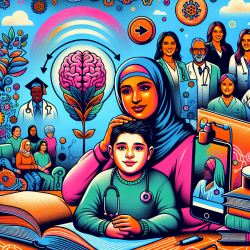Introduction
The transition from high school to college is a critical period for ethnic-racial identity (ERI) development among Latino adolescents. A recent study, "Ethnic-Racial Identity Developmental Trajectories Across the Transition to College," offers valuable insights into how ERI evolves during this transition. As practitioners, understanding these developmental trajectories can enhance our ability to support students effectively.
Key Findings and Implications
The study reveals that ERI exploration increases over time, while ERI resolution remains consistently high. This suggests that college provides new opportunities for students to explore their ethnic-racial identities, yet many students enter college with a strong sense of identity resolution.
Practitioners should encourage students to engage in activities that promote ERI exploration, such as participating in cultural events or joining student affinity groups. These experiences can help students deepen their understanding of their ethnic-racial identities.
Gender Differences
The study highlights gender differences in ERI development. Female-identifying students showed greater increases in public regard—how positively they believe others view their ethnic-racial group—compared to male-identifying students. This suggests that female students might benefit more from supportive academic environments that affirm their identities.
Practitioners should create inclusive spaces that celebrate diversity and provide mentorship opportunities, particularly for female students, to foster a positive academic experience.
Role of Cultural Orientation
Latino heritage culture orientation plays a significant role in ERI development. Students with a strong orientation to their heritage culture reported higher levels of ERI exploration and resolution before college. This indicates that cultural ties can be a source of strength and resilience.
Practitioners should recognize and support students' cultural backgrounds by integrating culturally relevant content into curricula and encouraging family involvement in educational activities.
Encouraging Further Research
While this study provides important insights, there is still much to learn about ERI development. Practitioners are encouraged to engage in further research to explore how different educational settings and policies impact ERI. Understanding these dynamics can inform strategies to support students from diverse backgrounds.
Conclusion
By understanding the developmental trajectories of ERI, practitioners can better support Latino adolescents during their transition to college. Encouraging exploration, recognizing gender differences, and valuing cultural orientation are crucial steps in fostering a supportive educational environment.
To read the original research paper, please follow this link: Ethnic-Racial Identity Developmental Trajectories Across the Transition to College.










